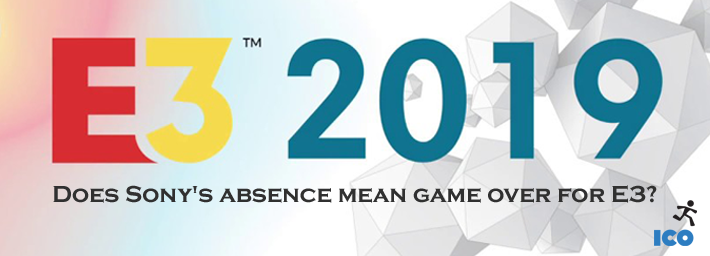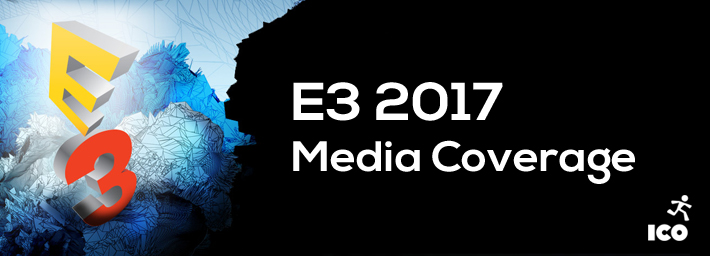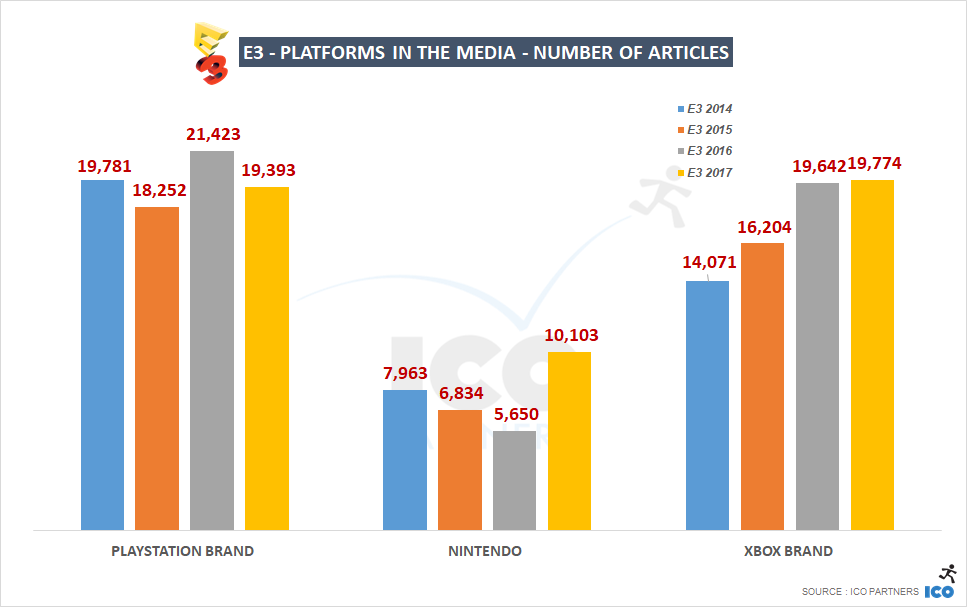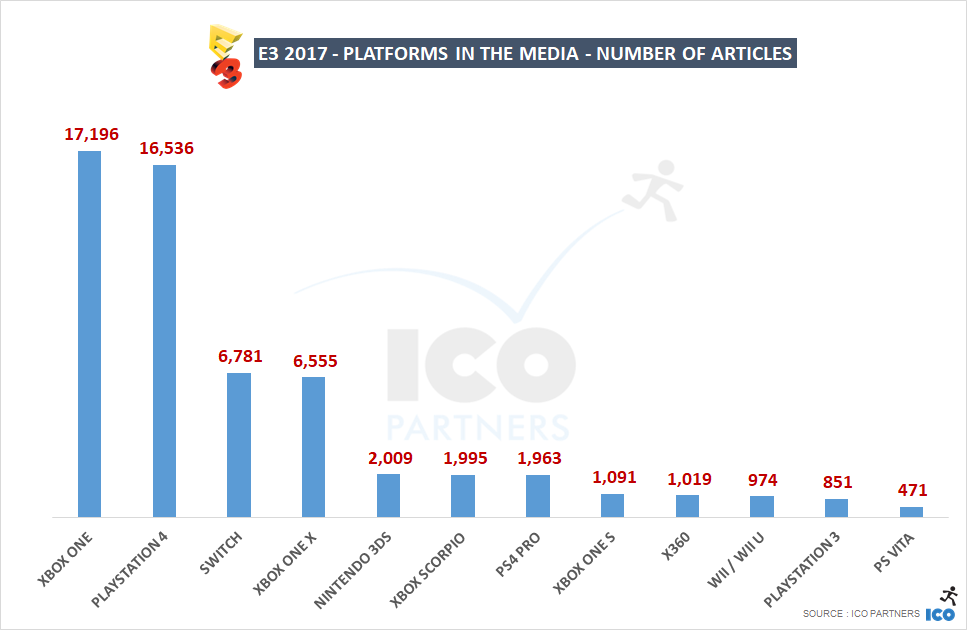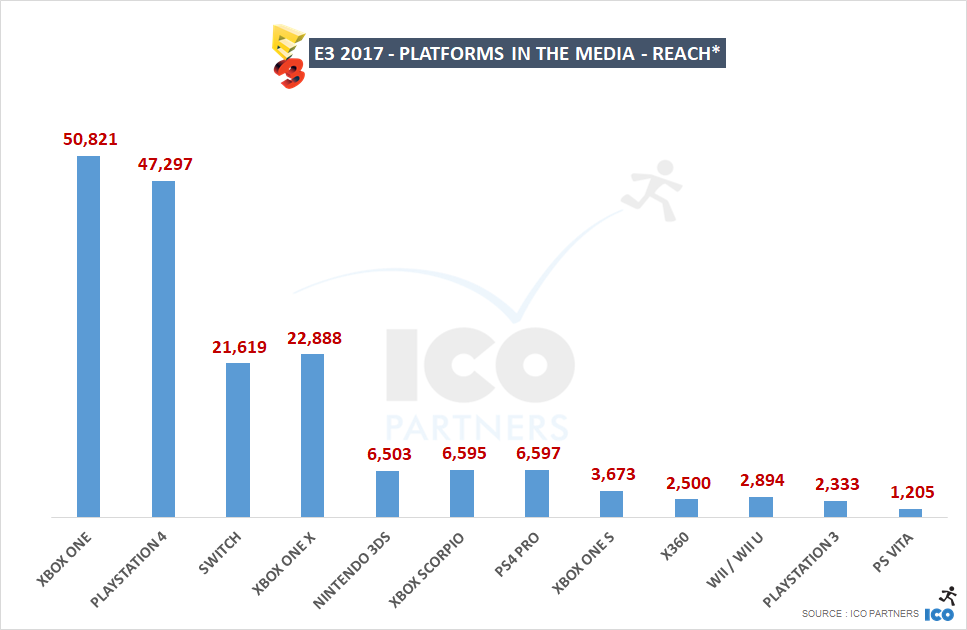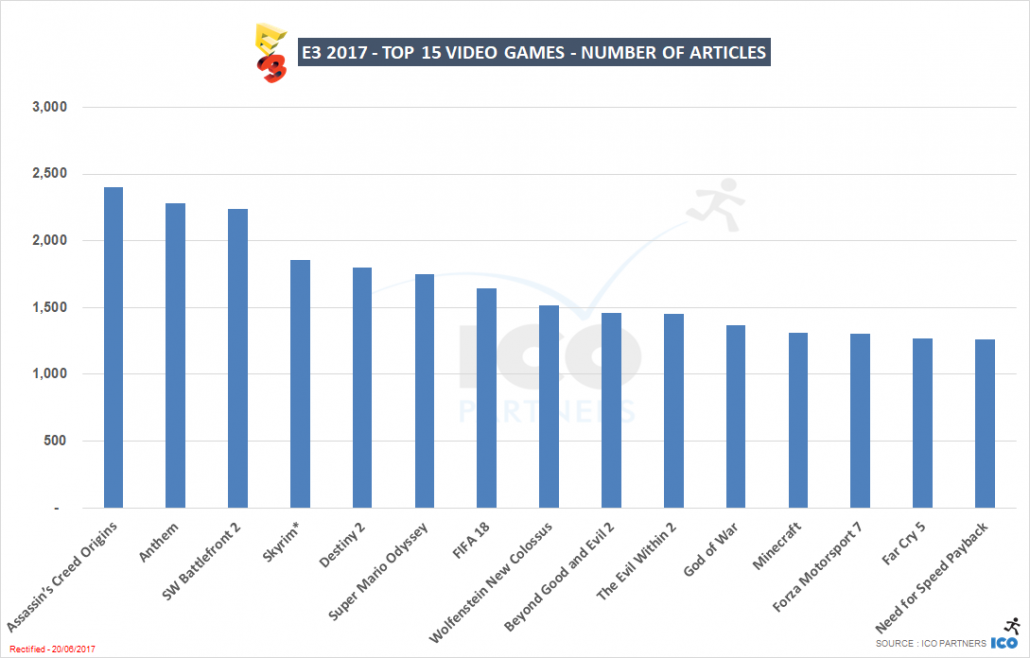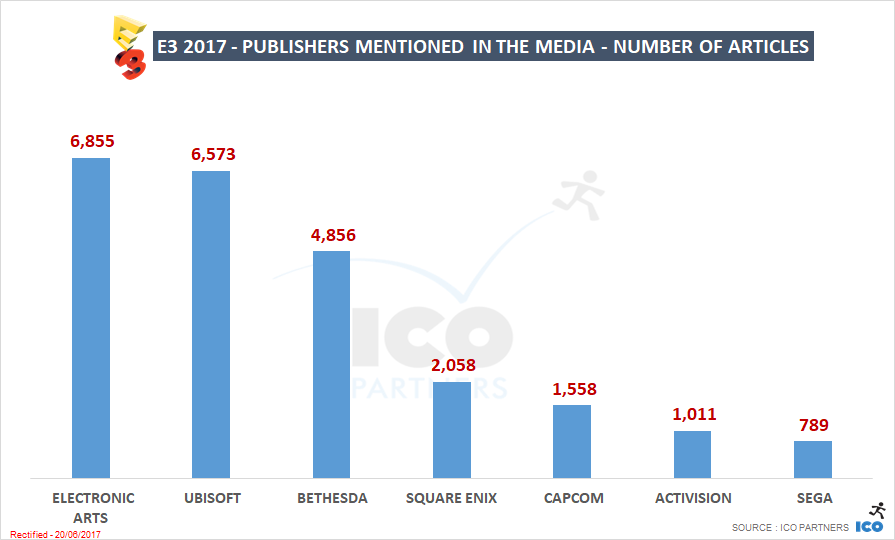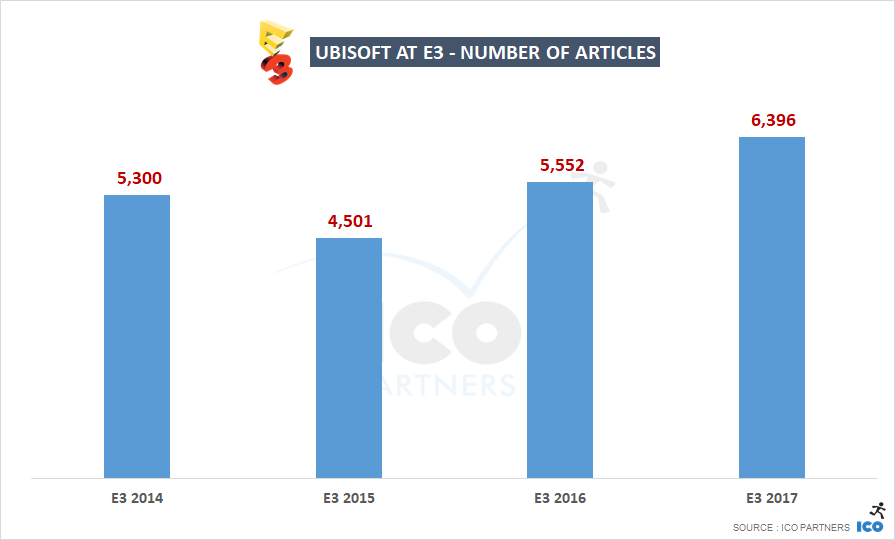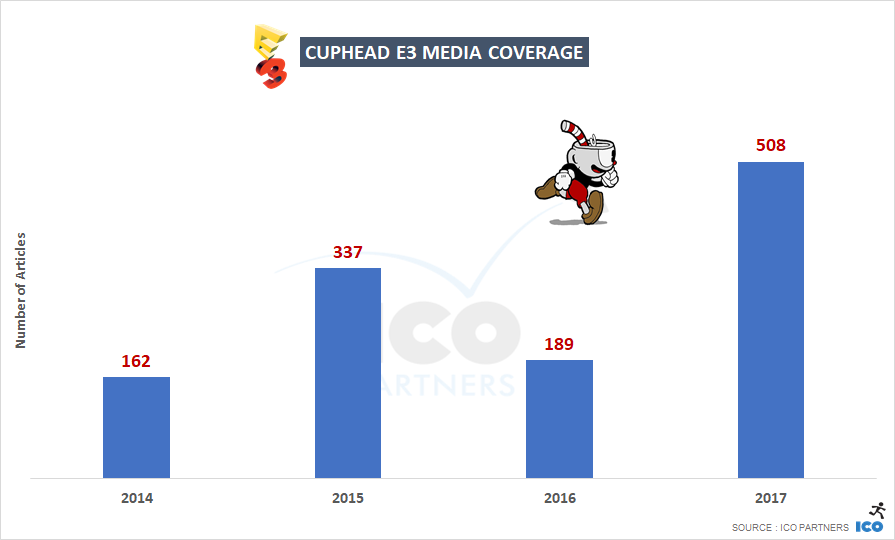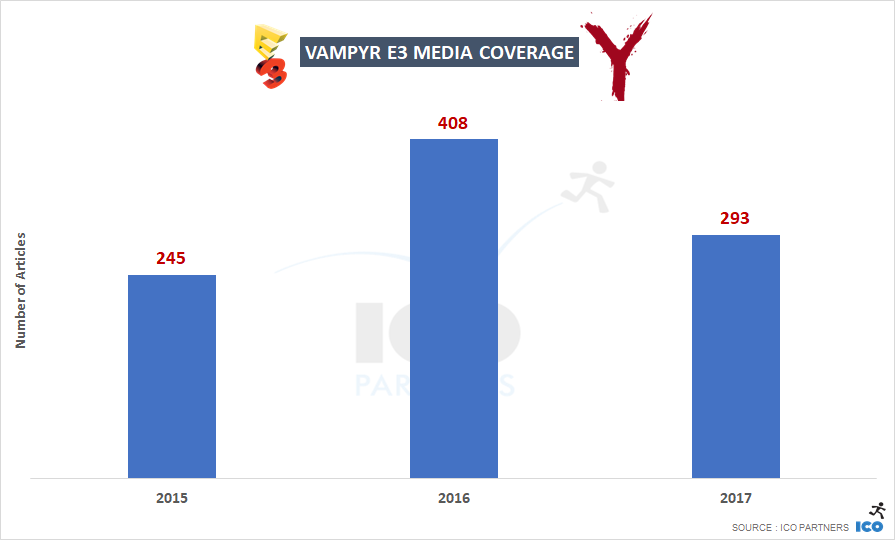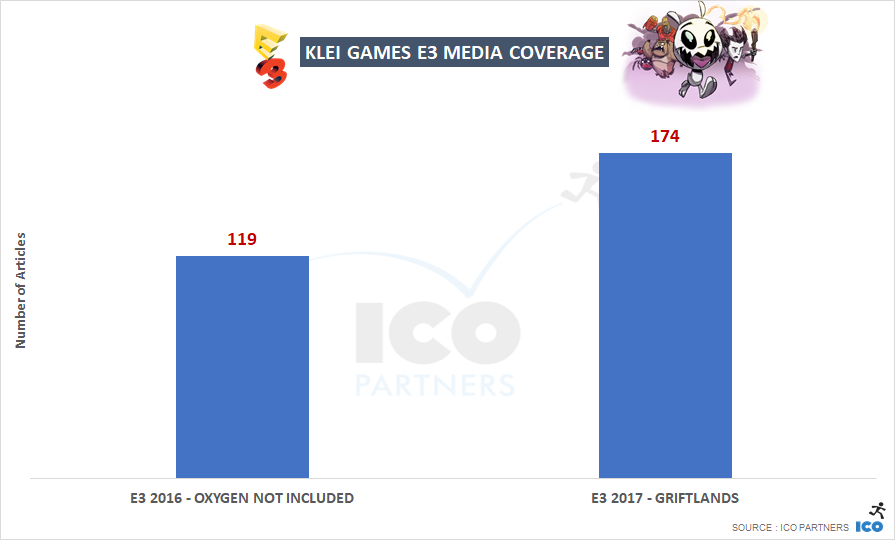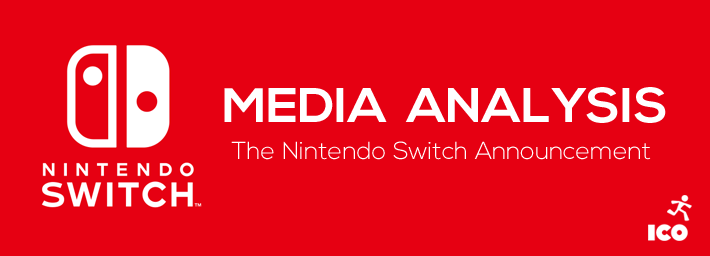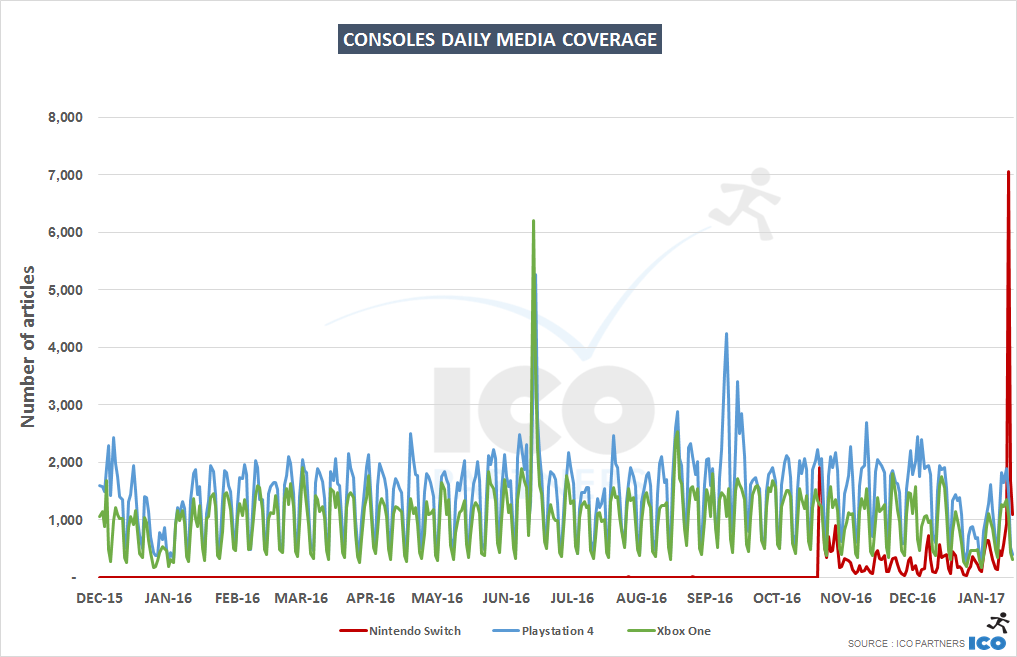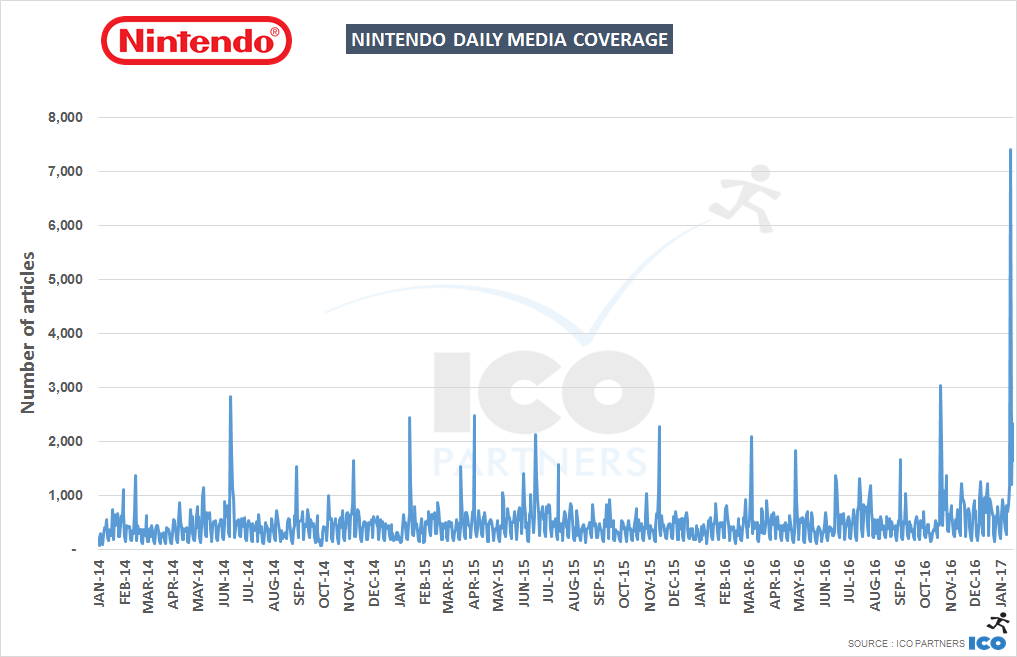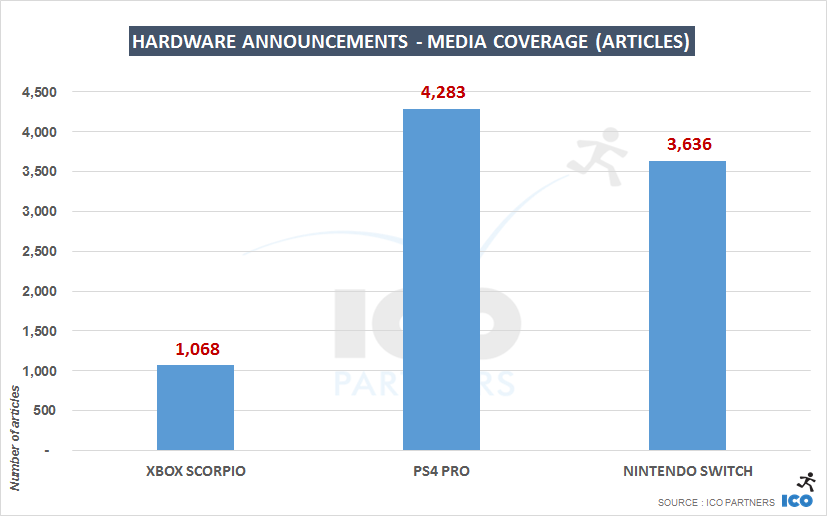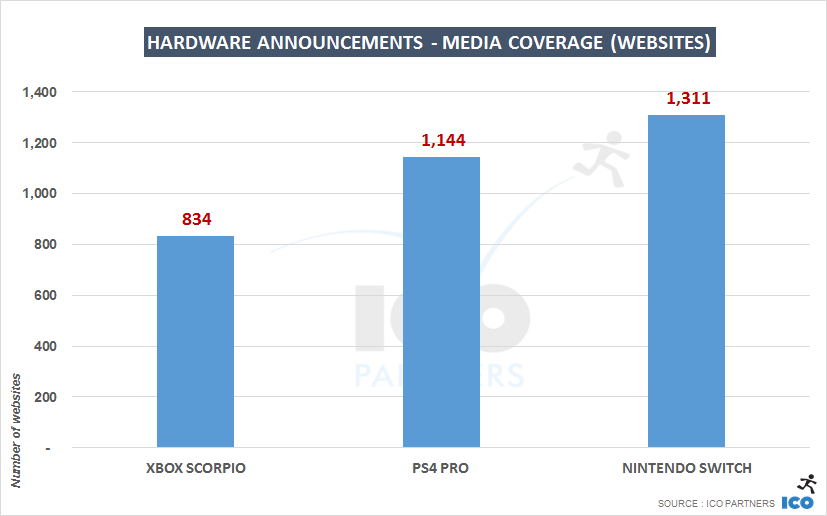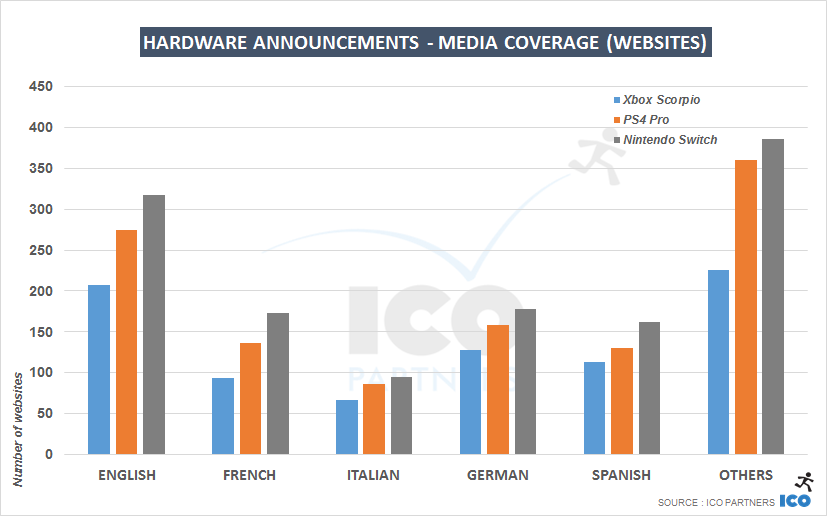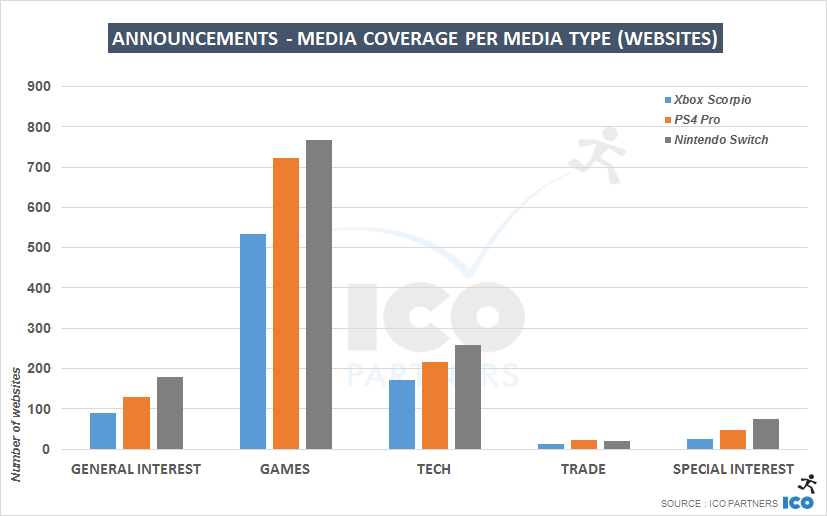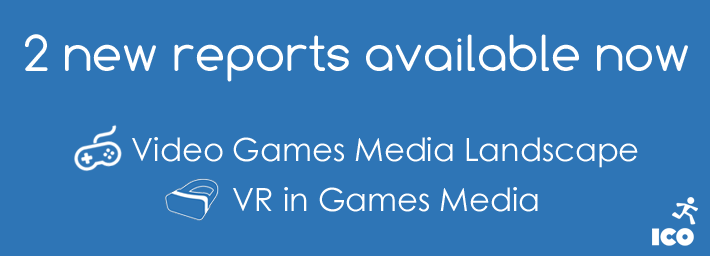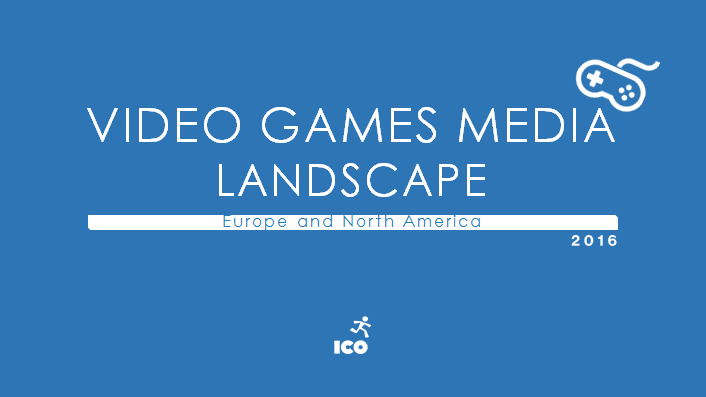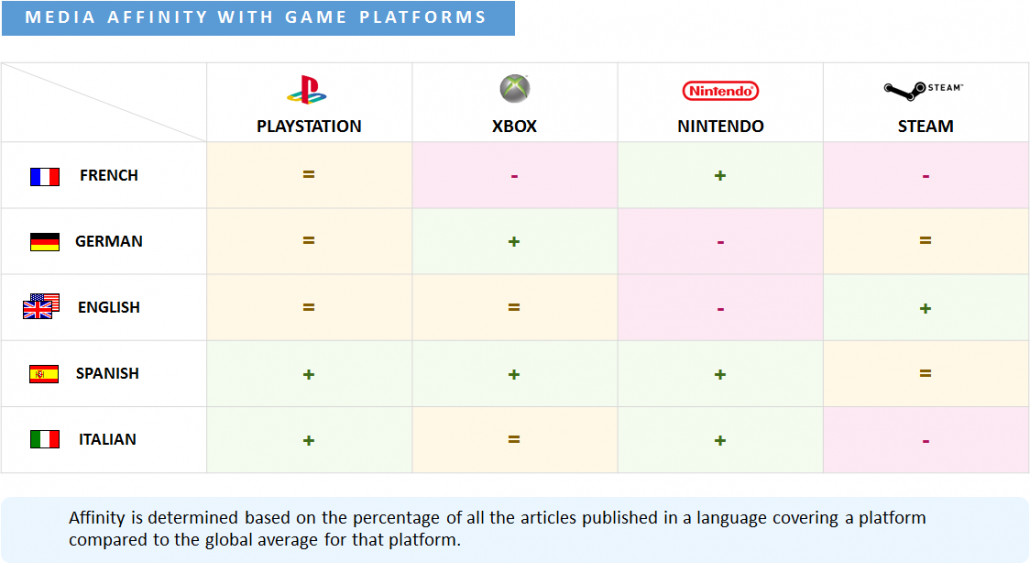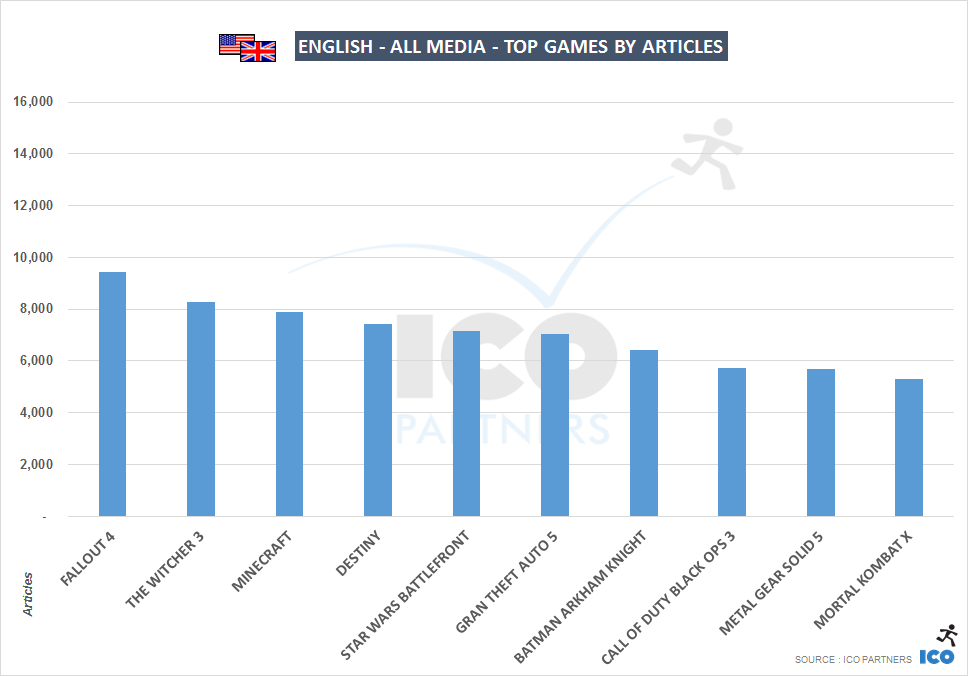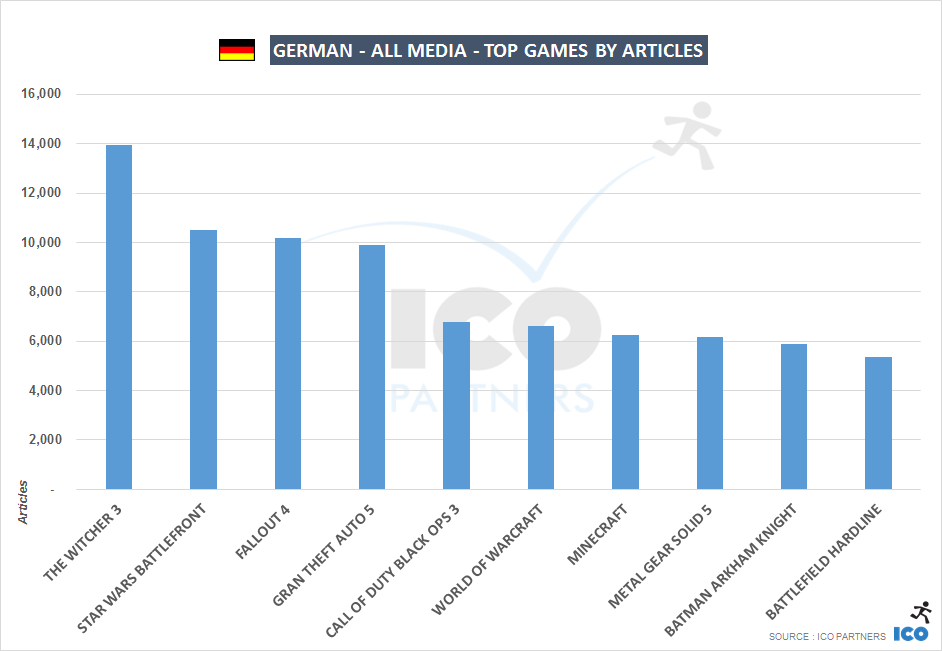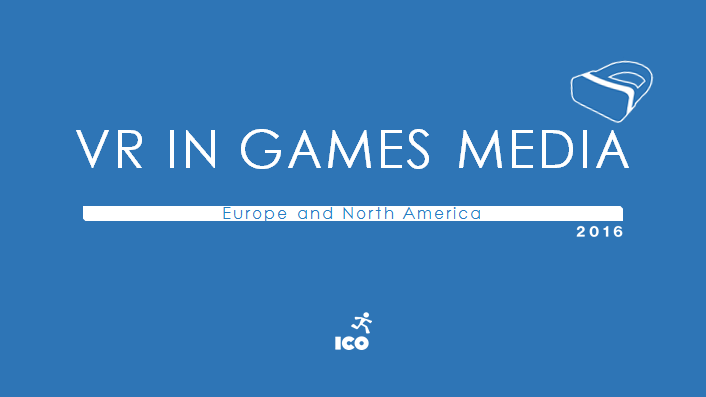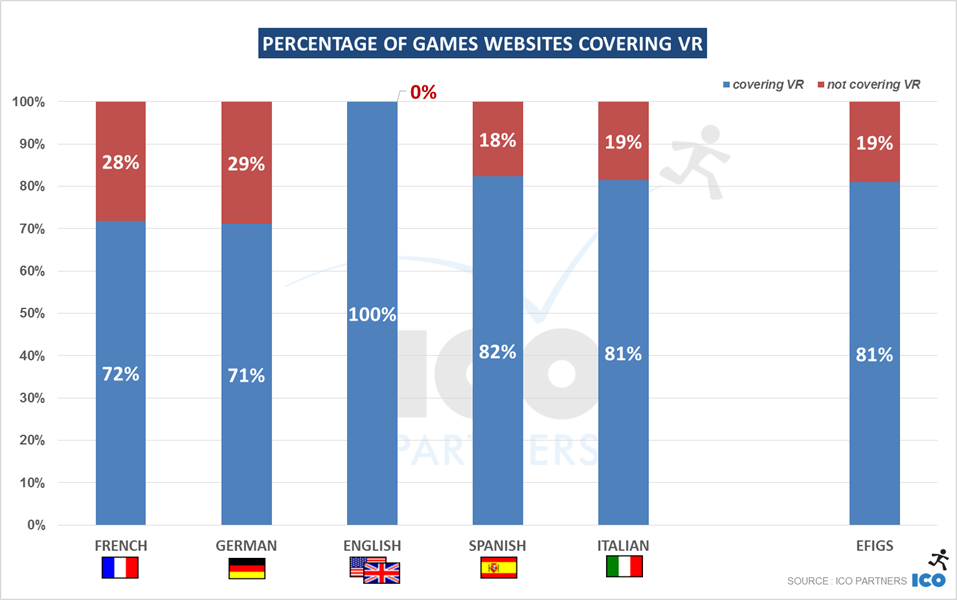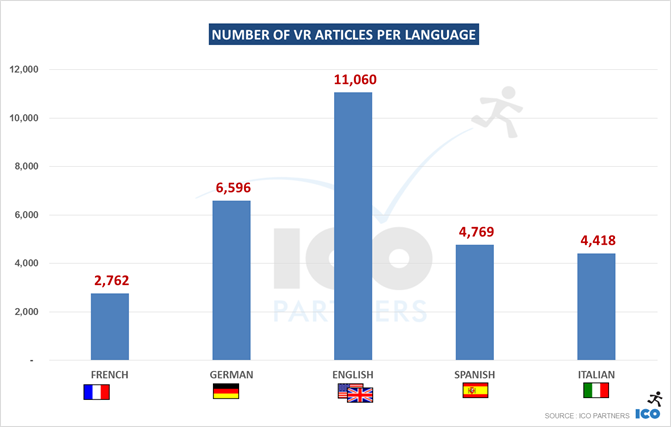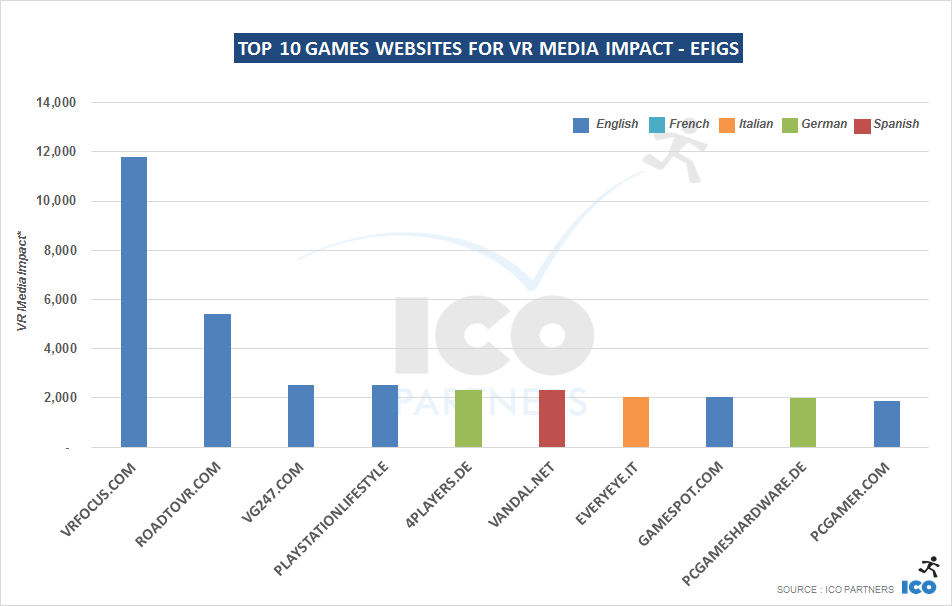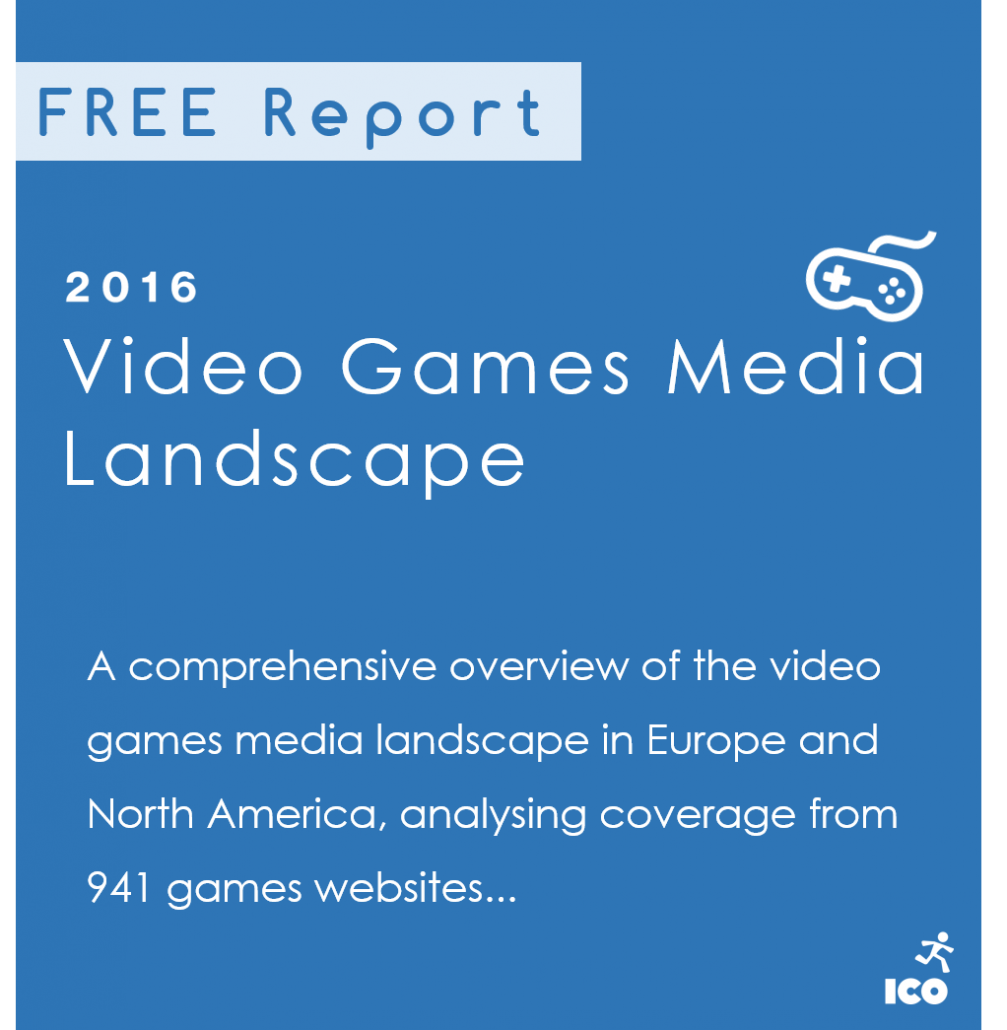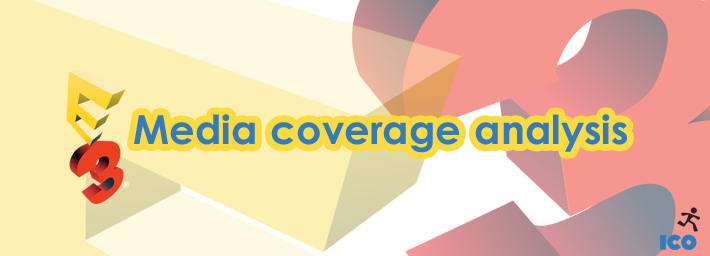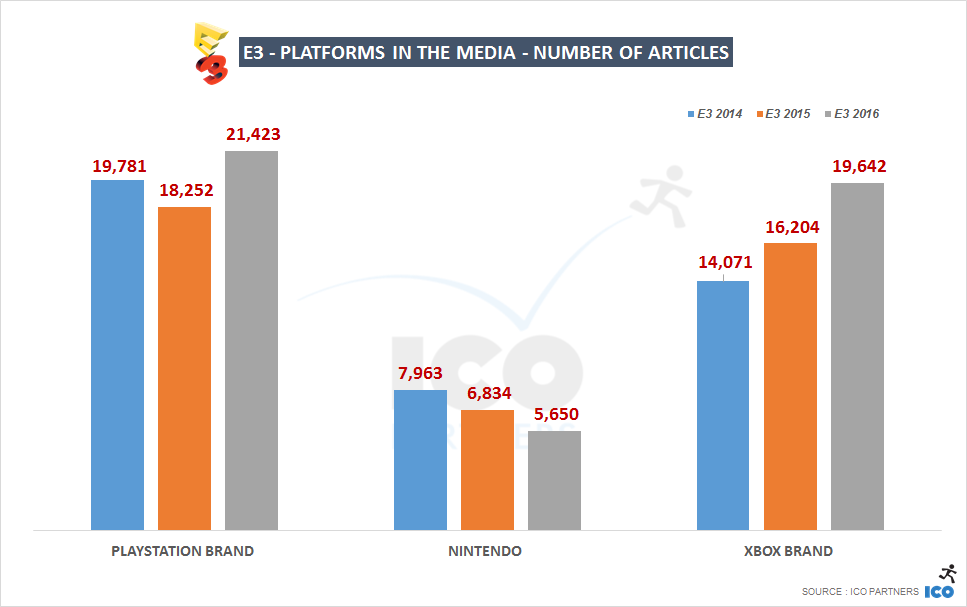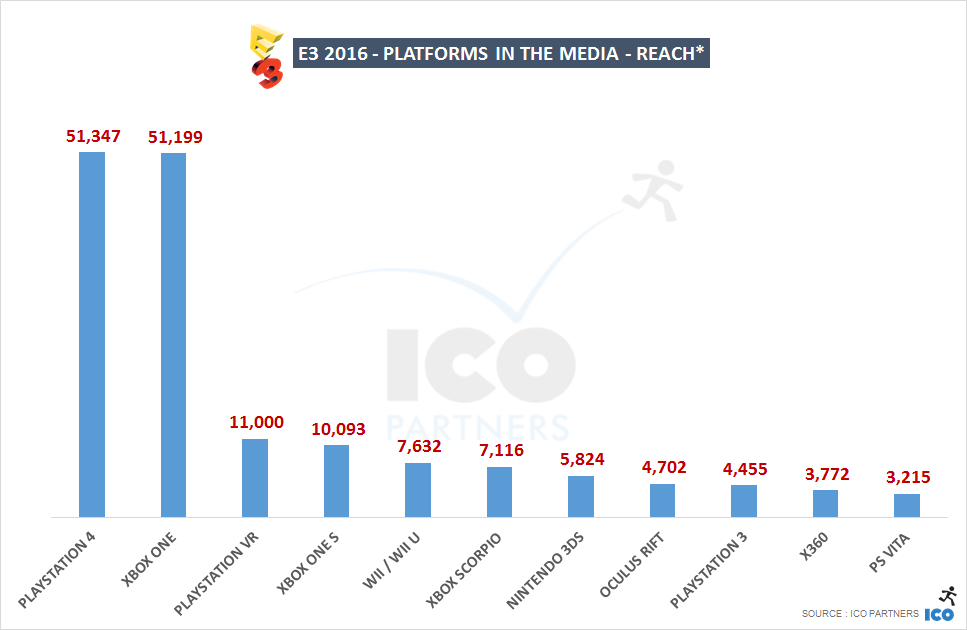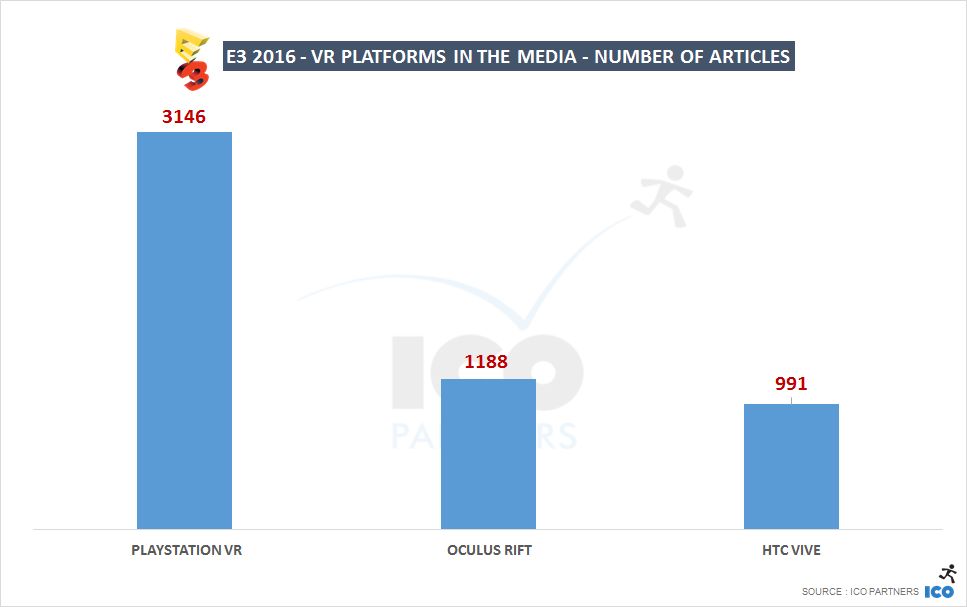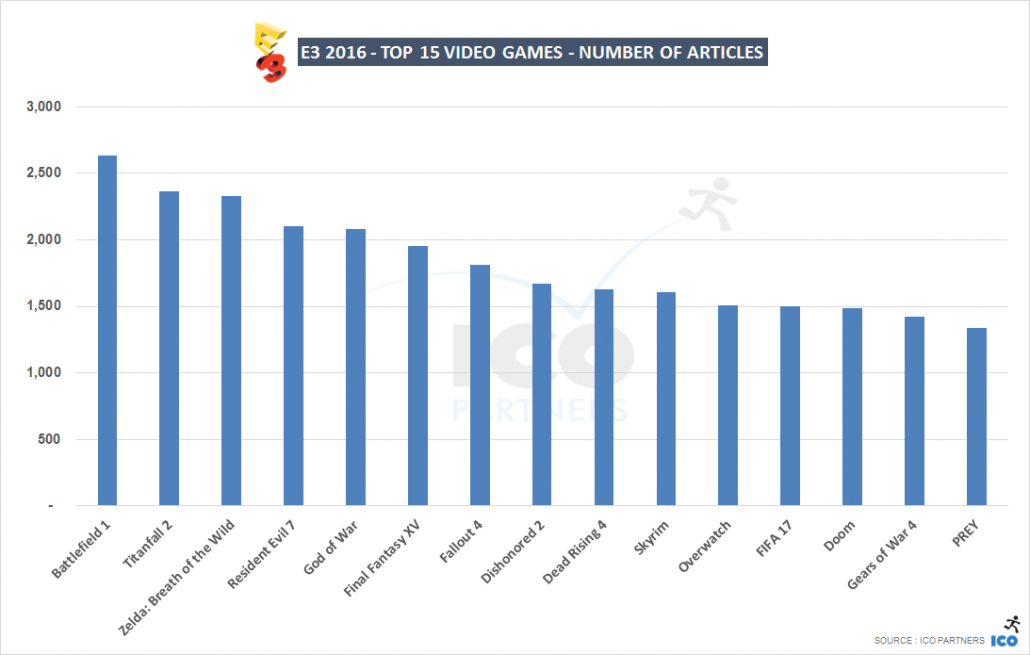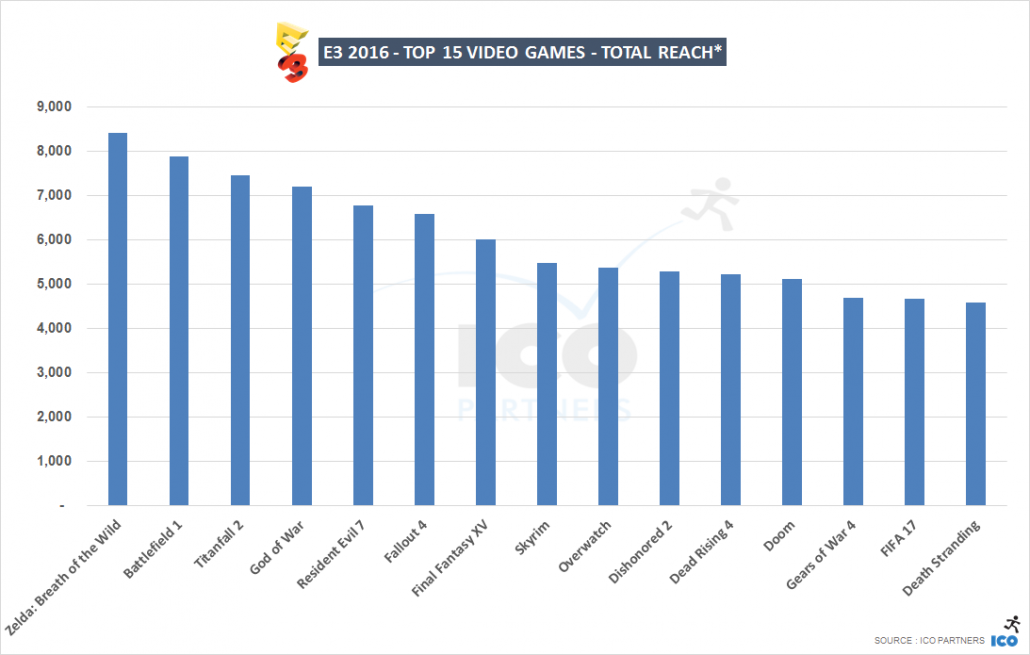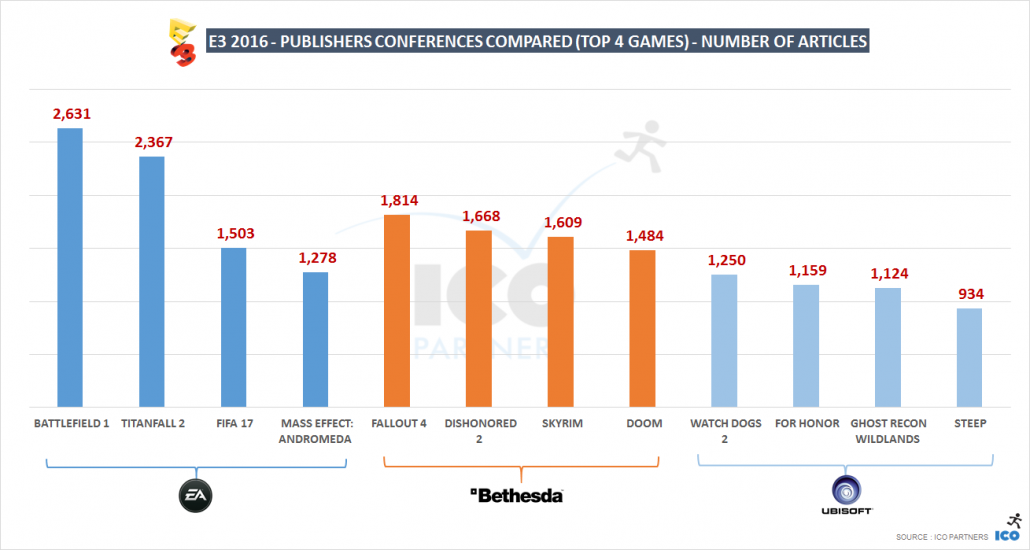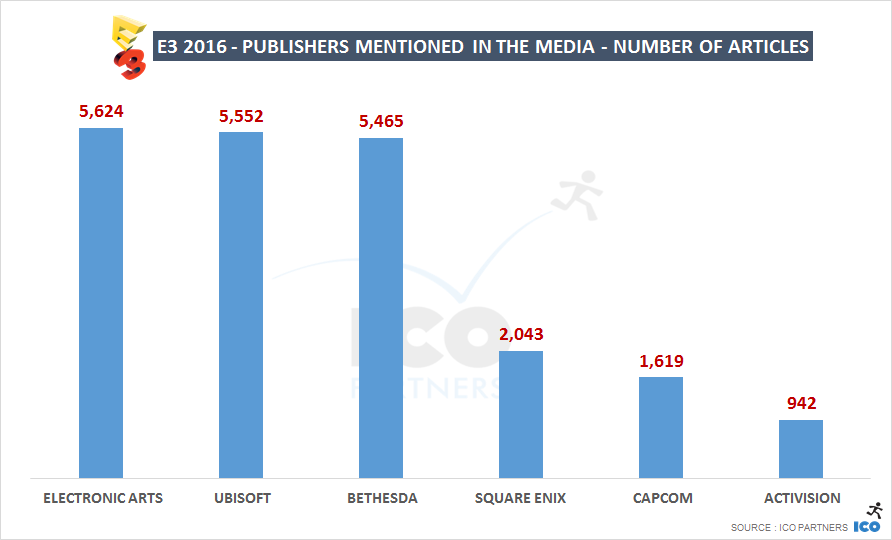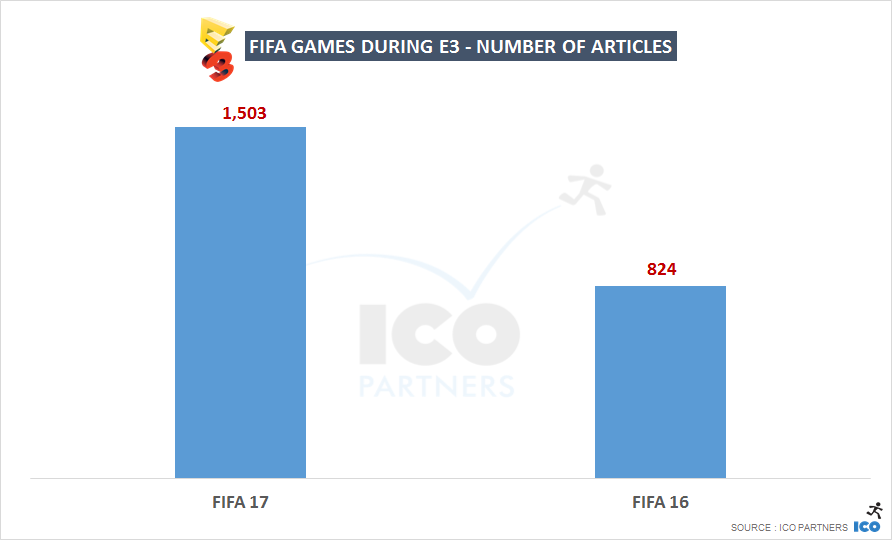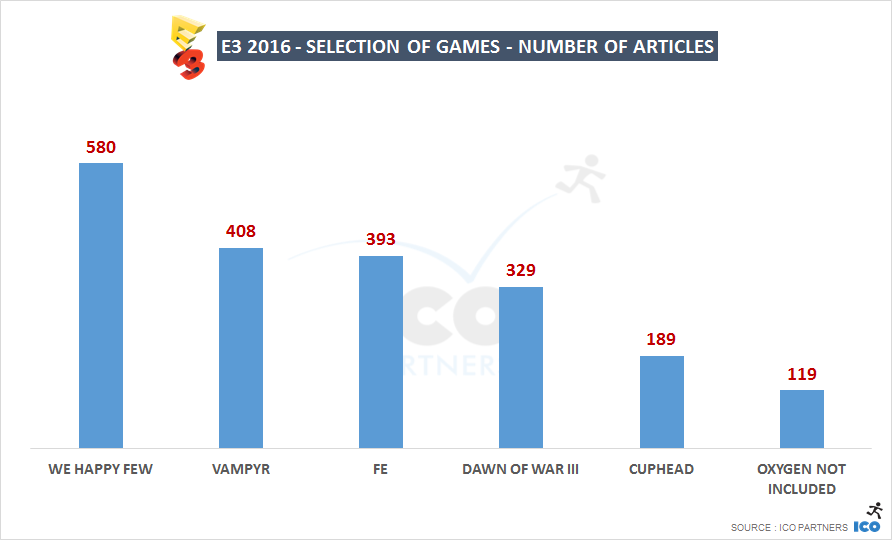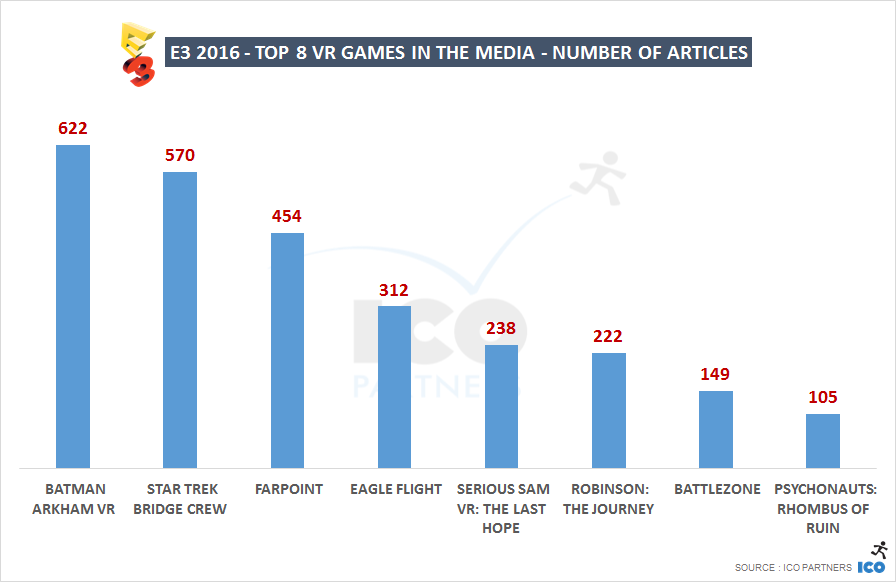The dust has settled on E3 2019, and it’s time for me to grab my Excel and run the coverage numbers from this year’s show. Read more
Posts
[EDIT – the dataset initially used didn’t properly cover the articles published on the 10th of June, making the EA coverage much lower than it should be. I have replaced the following graphs: Top 15 Games; Publishers Conferences Compared; Publishers in the Media]
It’s that time of year again: the week after E3, and time for me to go over the numbers and media coverage from the show, as per tradition. If this the first time for you, please fee free to have a look at the methodology used, and read the blog posts for 2015 and 2016.
Platforms
First, looking at the biggest players at E3, the console manufacturers, in many ways this was an interesting year in light of their performance at previous E3’s.
For the first time since we started measuring media coverage at E3 in 2014, Sony is not leading. It has to be said that the gap between them and Microsoft is very small, but this comes on the back of Microsoft growing for the 4th year in a row, and where Sony had its 3rd best performance out of 4 companies (on the back of its best performance last year).
Nintendo, on the other hand, has had its best E3, doubling the coverage they got last year. The Switch is clearly a commercial success and is also popular with the media. With a smaller lineup than its competitors, it is quite the performance for them. The wider 3rd party program, with Ubisoft’s partnership at the forefront, is likely a significant contribution.
Like last year, I created a Google Spreadsheet to list all the announcements done at E3’s press events – feel free to have a look for your own analysis of the lineup announced for each company:
https://twitter.com/icotom/status/874684542220722176
Personally, here are my thoughts on the 3 manufacturer press events:
- Microsoft. It was their best E3 conference to date, as far as I am concerned. They finally hit the right tone in their announcements. However, nothing they have announced is really pushing the Xbox consoles over their competitors. Not many exclusives that would drive someone to pick an Xbox over anything else. The Xbox One X, if anything, is a console for the convinced customer, the one already in the ecosystem.
- Sony. The conference wasn’t mind-blowing, and the media coverage reflects this, but I think Sony was just playing it safe. There have been enough PlayStation exclusives to come out ahead of the show to allow them to message the console as the better alternative in terms of catalogue. The numerous VR games shown was a great reminder of the PlayStation VR, a strong differentiator when compared to other consoles. My biggest issue with the event was the format. It was hard to understand if the pre-show was meant to be considered as part of the main event – and many of the more interesting projects were revealed there. I will also note that during the show, the dates of this year’s PlayStation Experience were announced. This is a strong message that PSX is becoming the main press event for Sony, and I wouldn’t be surprised if they’ve held back a number of high-profile announcements.
- Nintendo. The numbers are quite telling – this was the best E3 for Nintendo in years. They were coming off of the back of an excellent launch for the Switch, and announced a number of high-profile games that are coming out very soon for the console. In terms of short-term hype, this was brilliantly executed. I am still somewhat confused by the Pokemon and Metroid Prime 4 announcements – they are likely to hype a core fanbase, and have the risk of setting expectations beyond what is being developed. I find announcements of this type are better done with something to show in order to frame what is being put together. But who knows with Nintendo? They may well knock these titles straight out of the ballpark.
Looking at specific platforms, a few things are interesting to highlight:
The Switch got more coverage than the Xbox One X last week – which is impressive considering the higher profile of the Xbox brand. Also impressive: the 3DS is still getting a decent amount of coverage.
The main point to consider, looking at the reach of each console, is the fact that the Xbox brand seems to be very good at getting covered by higher profile media. The short lead the Xbox One has over the PS4 is translated to a more significant lead in reach. And the Xbox One X, being slightly behind in terms of the number of articles compared to the Switch, sees a significant lead when considering the corresponding reach.
Finally, I wanted to check the VR device coverage, to compare it with last years.
Again, PSVR is leading. But, there were about half as many articles as at last E3. That’s a steep decline, most likely due to the fact that the speculation on VR is now in a different phase, with all the devices on the market and being known quantities.
Games
Like the previous year, I looked at the top games based on the volume of media coverage.
Here are a few thoughts coming to me immediately after looking at this list of games:
- [This was what was initially written in the article] EA didn’t do as well as last year. At that time, they had two games that had more than 2,000 articles. This year, Anthem, their best performing game, doesn’t reach that threshold. It’s interesting to note that Anthem is the only newly announced IP on the list.
- [EDIT – Anthem and Star Wars Battlefront 2 show up as two very strong titles in the EA line-up, bringing the total number of games passing the 2,000 articles during E3 week to 3 this year, compared to 5 in 2016. EA keeps 2 titles in that threshold though, a solid, constant performance.]
- Assassin’s Creed Origins is leading for a number of reasons: the game was featured significantly at 2 press events (Microsoft and Ubisoft) on top of being playable at E3.
- Skyrim is marked with an asterisk because it featured in a few different capacities: the Switch Port during the Nintendo conference, the PSVR port during the Sony conference, as well as the fact that the next expansion for Elder Scrolls Legends is featuring Skyrim. This means it’s more difficult than usual to point to this as a game singularly featured.
- With only one game in the 2,000+ articles category for coverage, 2017 is a year with weaker big game announcements than 2016 (which had 5 games in the 2,000+). It says nothing about the quality of the games of course – it is purely a statement of their media coverage.
There were 3 publisher-powered press conferences this year, with Square Enix skipping it again this year. Ubisoft, after three years of growth, is finally coming on top, in large part thanks to the Assassin’s Creed Origins coverage.
[This was what was initially written in the article] EA didn’t seem to manage to secure the right attention. It might be the EA Play formula that didn’t work as well as last year (a single location this time), it might mean the lineup didn’t catch the attention in the same way that last year did. It has to be said that FIFA 18 being a top game for EA this year isn’t actually a good sign, as FIFA 18 didn’t get as much coverage as FIFA 17 had last year. The most disappointing of all is the coverage for Battlefront 2, considering the power of the Star Wars brand and the release this winter of Episode 8.
[EDIT – With the proper dataset, EA’s performance is much more in line with the profile of the company over the past few years, with Star Wars Battlefront II as a top game, and Anthem’s performing very well, in great part due to the double featuring at the EA conference and the Microsoft event]
Bethesda did OK – the two new games obviously getting most of the coverage. But the really strong IPs of the publisher, Elder Scrolls and Fallout, had no revolutionary announcements around them, and in that respect, Bethesda still performed quite well considering.
Finally, Ubisoft’s conference was praised by many attendees and analysts as the best of the show. It had a wide range or projects showcased, an unexpected number of new projects revealed. The lineup was very strong, and then Ubisoft also managed to throw a few curve balls. The fact that they’re going after the declining toys-to-life market with Starlink was totally unexpected, for instance.
Looking into the publishers’ names and how often they were mentioned in the media reinforces the apparent success of Ubisoft:
All 3 companies with a press event did far better than all the others which didn’t. Bethesda and EA both had significantly less coverage than last year though (-25% for EA; -15% for Bethesda). And to nail down Ubisoft’s stellar performance this year, you can look at the progression over the past two years:
Case studies
No short selection of games for this year’s case studies. Instead, I looked at how 2 games’ coverage evolved year-on-year, and how two games from Klei compared to each other a year apart.
After its 4th year being featured at E3, Cuphead is finally going to be released. This illustrates quite nicely how much having a release date helps you coverage-wise. At this point, the game has been covered a lot over the years. The fatigue shows through the numbers at E3 2016, so the 2017 numbers overall indicate a very good performance for a game of that profile.
In its third year at E3, the Dontnod title coverage illustrates a few interesting points:
- Its first year at E3, the game wasn’t featured at any conference, and it had a very decent coverage considering.
- Last year, it was featured during the PC Gaming Show, showing the significant visibility this smaller press conference can still bring you.
- This year is the last one before the game releases. The date has been announced, a feature video was released the previous week (and thus mostly absent in the numbers above), gameplay was at the center of the communication at this E3’s beats. A strong coverage overall, even if not in the range of blockbusters.
These projects by Klei are very interesting to compare: they were both revealed at the PC Gaming Show. It is very difficult to get comparable data over time, but this is quite interesting – two games by the same developer, announced at the same conference at E3.
I haven’t shared data over the PC Gaming Show in the past, and it is mostly because the branding is not as strong and many announcements get relayed without mentioning the event. The fact that a games media outlet is attached to the event as the organizer might play a significant part too. Anyhow, there is evidence of growth in coverage for games featured at this event, and Klei’s games illustrate this quite nicely.
Closing words
I have always felt a bit conflicted about titling these articles “Who won E3?” as there is much more to the data than that. However, this year’s E3 is a bit of an exception. The announcements made, the reaction of the media to them, the progress of the media coverage over the past few years; all of this make me want to declare two, very complementary “winners”.
Nintendo – as they come back into the spotlight and significantly increase their media presence, this has certainly been the best E3 in years for them.
Ubisoft – with their numerous announcements, the way they were orchestrated, and the stellar execution of the Beyond Good and Evil 2 trailer release, all explain how they ended up as the leading publisher of this E3 in terms of coverage.
And I want to think that the two companies’ partnership also played a big role, and is probably not a coincidence considering the position they both have at present in the industry, and their respective challenges.
A few technical notes
Why Nintendo and not the Wii?
In the graphs on consoles over the past 3 years, I am comparing the PlayStation and Xbox brands to Nintendo. The fact is that the other consoles have consistent brands whereas Nintendo machines are using multiple brands. Moreover, Sony and Microsoft are two companies with activities spread across multiple industries and cannot fairly be compared to Nintendo, when we look at articles on games. Nintendo is also a strong publisher, and its brand is more established than one of its consoles, compared to Sony and Microsoft. Comparing platforms to brands is the best way to have comparable results to look at the Nintendo brand, rather than the Wii for instance (or even a combination of the Nintendo consoles).
What is the reach value?
* Like last year, I am referring a few times to the notion of reach. Here is a reminder about it:
The following graph requires some pre-explanation. In order to measure the magnitude of an article, with have created a formula based on the websites’ Alexa ranking to give their articles different “weight”. The more popular the website, the more weight we give to their article. This value is called Reach in our tools and range from 0.1 to 10. For example, currently, Eurogamer.net has a reach of 10, Gamasutra.com has a reach of 8, Road to VR has a reach of 6. So what you see below, is a chart of the total reach of all the articles showed above. We refresh the reach values constantly.
Back in October, I did an analysis of the announcement of the Nintendo Switch. It was a rather short one, with very few details shared at the time, with the promise of a more in depth presentation following an event in January. That event was last week, and now is a great time to look at how it went for the Nintendo teams.
The Console
There is no question that, of the three console manufacturers, currently Nintendo is lagging behind Sony and Microsoft and that is very apparent when looking at the media coverage of each console.
In the video games media landscape report that we shared last year, Nintendo received less than a third of the articles that PlayStation had. In that respect, the Switch announcement seems to have been fairly well covered. We are lacking data to compare it with other console announcements, though.
Here is another graph to illustrate how significant the event was for Nintendo’s coverage:
While it is not surprising that the main event showcasing a new console is the single biggest media event for Nintendo in the past 3 years, the scale it reached is significant. It is the single biggest announcement in terms of volume of coverage across all 3 main consoles for that period of time. For Nintendo, a company that is struggling to compete with the media attention its two contenders receive, it looks like a massive achievement.
And with the new cycle of consoles being upgrades from the current gen, rather than brand new iterations, this might stay true for a while for all we know.
Games
* Minecraft numbers are only for articles explicitly naming the Switch and Minecraft.
Looking at the games announced at last week’s event, there seems to be 4 categories:
- Zelda is alone in the lead, with twice as many articles as any other games. Nothing surprising here: it was the crown jewel of the line-up, the game that was playable on-site, and it’s the one key launch title for the console. It is interesting to note though that it is garnering even more coverage than at last E3, where it was one of the leading game in terms of coverage (2,300 articles over a week compared to 2,600 articles since Friday)
- Nintendo’s first party titles – they benefited from the full support of the firm’s communication effort. It’s also interesting to note that existing licences are performing better than the new brands. This is very normal of course, but interesting to actually see it in numbers.
- 3rd party titles from key Japanese licences – I put in this bucket Bomberman, Fire Emblem and Xenoblade, that all received 400+ articles from the event.
- Other 3rd party titles – this is of course more varied and spread out, but I think it’s worth noting Snipperclips and Octopath both securing more than 200 articles – no small feat for projects with their profiles.
That’s it for me (for now).
This month has not only been busy with new game releases, as expected for this time of the year, but also with new announcements. On the back of the analysis of the PlayStation VR release and its media coverage, I went and looked at the media coverage that the recent Nintendo Switch reveal has secured.
A tweet and a video
There are not many console announcements; their life cycle is long enough to make them a rare occurrence. Our media monitoring tool has been running since mid-2013, but getting really in shape from early 2014 onwards, so I don’t have much data to properly compare the Nintendo Switch announcement. I will mostly use this year’s PS4 Pro and Xbox Scorpio announcements, keeping in mind that these are not full-blown new hardware being released, but upgrades of existing consoles.
The way the Nintendo Switch was announced is also unusual. It was outside of any major media event and in the middle of the busiest month for video games media with the release of many AAA titles; a new format for this kind of announcement. Also, Nintendo has been very sparse when it comes to details about the console (no detailed specs, no price point, no confirmed release titles), and stated clearly that they wouldn’t provide any of this until nearly next year.
With all this in mind, how well was the announcement covered by media?
Purely looking at the number of articles, the Nintendo Switch secured fewer than the PlayStation 4 Pro did at its reveal back in September, but way more than the Xbox “Scorpio” did at E3. I would call this a small victory for Nintendo, if only because there is very little to talk about on the Switch at the moment. Of course, there are many speculative articles, but it doesn’t feed the media cycle the way the Sony press conference did, where there was a price point, technical specs, and titles to discuss.
But to call it a win, I have to say I had to double check the number of unique websites that wrote about the consoles first:
The Nintendo Switch managed to secure coverage across more media than the PS4 Pro or the Xbox “Scorpio”, even if not in a massive way. Nintendo is clearly behind the two other console manufacturers, and it shows in the monthly tracking we do on the coverage of each platform, so being able to get this amount of attention is good for them. It is the biggest beat related to the Nintendo brand since we started tracking media coverage (January 2014), but it is still way behind what Sony and Microsoft gained for their biggest announcements in the period (usually around E3, but not exclusively, as the PlayStation Experience managed to build a lot of significant coverage the past couple of years too).
Where is the interest?
Looking at the same metric (unique websites covering the announcement), there is a similar level of increased interest for the Nintendo Switch compared to the PlayStation 4 Pro across most languages. The notable exceptions being French and Spanish media, which covered this announcement in a bigger proportion than the other languages (and which makes sense considering the findings from the report on the different media landscapes) and Italian media where the increase was smaller than the other languages (and contrary to the same findings).
The websites parsed by the monitoring tool are also put in different categories and this is where an interesting pattern appears for this announcement:
Nintendo is often seen as a family-friendly brand, one that has a wide appeal and name recognition outside of the video game industry. The bigger reach the Nintendo Switch announcement had with General Interest media would reflect that, and is quite significant here (note that the tool’s database is very much geared towards video games media and is not as exhaustive when it comes to media from different categories). But the significant reach the news had with websites qualified as Special Interest, is one I didn’t expect. Special Interest media cover a range of very specific topics, generally only tangentially related to video games. For example, it includes websites that focus on board games, “geek culture”, and science-fiction in its broadest expression. The news seems to have found a very strong resonance with those media compared to the “upgraded console” announcements.
All in all, this was a massive announcement for Nintendo, one on a scale that they don’t often have. And while it worked and found a significant reach in the media, it was not spectacular. Pokemon Go, at its highest week, saw a lot more coverage than the announcement of a brand new console. Of course, Pokemon Go was an extraordinary phenomenon, but so should be the reveal of your new device.
Here are the last couple of numbers to give some food for thought: at the time of writing this blog post, 5 days after the reveal, the Nintendo Switch reveal video on Youtube had 17m views; the Battlefield 1 reveal trailer had 22m views over the same time period.
Today, we are releasing two new reports, both available from our website. These are our first public reports built using the data gathered using our media monitor and you can probably expect more like these two in the future.
The first report, which is free (you can make a donation when you get it on Gumroad, if you do, we won’t mind), is a look at the overall landscape of those media that are dedicated to video games.
The second report, which is not free, is a deeper and more specific look at video games media and their coverage of VR, focusing on the key platforms (Oculus Rift, HTC Vive and PlayStation VR), the mist VR-friendly media, and the key VR games that were covered.
Rather than describing them, let me share some of the findings of the reports.
Video Games Media Landscape
One of the things the report looks specifically at is the coverage received by the major gaming platforms over a year.
There are two things we considered when looking at the relative media presence of those platforms.
First, the percentage of websites that mentioned the platform at all.
There are two very clear leaders, with both Xbox and PlayStation having 95+% of the games websites mentioning them. The main consoles are so ubiquitous that it is surprising that they aren’t at 100%, to be honest. But you have to account for PC-only media as well, and they are unlikely to have much coverage of the consoles.
More surprising is how Steam, which is not a platform that has a very pro-active communication strategy, still has 90% of the websites mentioning it. This is ahead of the Nintendo platforms (Wii, Wii U, 3DS) standing at 86%.
Then, beyond the websites, we also looked at the volume of articles for each platform:
If you are familiar to the blog, you won’t be surprised to see PlayStation ahead here. They have a very strong media presence, and they are constantly ahead of the other platforms in terms of media coverage. In terms of scale, that’s still 3 times the total number of articles mentioning the Nintendo brands, and almost 30% more than the volume of articles mentioning the Xbox brand.
Steam being behind matches with what we were referring to earlier, and the lack of a concerted communication strategy on the platform from Valve. Much of the coverage is inherited from studios and publishers launching their game on the platform, and without consideration for the brand presence.
One objective of the report is to provide some reference points in regards to how different the media from the different countries are a different from one another. We are able to put together this table to show what we called the “media affinity” for certain platforms based on the language of a website.
One very interesting pattern is how French, Spanish and Italian media, all based in Mediterranean countries, have a stronger affinity to Nintendo platforms compared to websites in German or English.
This is not to be interpreted, for instance, French websites having more coverage on the Nintendo consoles than on the Xbox ones. But in proportion, French media are writing more articles on Nintendo than the German media. I think this is an important consideration – as this helps understand the different sensibilities of the different cultures when it comes to games platforms.
Here is another very telling example. Below are the top 10 games in terms of media coverage in English and in German, for the calendar year 2015, set at the same scale.
We discussed in the past how The Witcher 3 was the most mentioned game of 2015, across all the languages we track. But in English it only came second, behind Fallout 4. In German, The Witcher 3 is the clear winner with a third more coverage than the second best game… Star Wars Battlefront!
Another interesting takeaway is the very strong media coverage in German for World of Warcraft. The game doesn’t make it to the top 10 in any other language. World of Warcraft had more articles in German than Metal Gear Solid 5 had in English.
We made the landscape report free to anyone, you just need to enter your email and ask for a download link. We wanted this report to serve as a foundation for other reports we are writing, and making it free allows us to use it as a reference points across different things we are building.
Virtual Reality in games media
Our second report is more in-depth, is not free, and is looking into the media coverage of one of this year’s strongest trends, Virtual Reality. This report is also covering a full 12 months of coverage, from May 2015 to April 2016.
One of our findings was done by looking at the ratio of websites that covered VR in some way, compared to the ones that didn’t cover the topic at all.
The criteria being very generous (any mention of VR or a VR related device), we were expecting very high percentages. We found two things we didn’t expect:
- 100% of the English websites we track mentioned VR in a way or another during the 12 months period. It is very unusual to have such a perfect score, especially considering the tool has it own flaws, and it would tend more towards missing mentions rather than finding false positives. VR as a topic for video games English media is there and is very strong.
- More than 25% of both French and German media didn’t cover VR in any way during the period. That’s significantly behind the average observed, especially considering the very generous criteria we used there.
Looking at the volume of content shows another different trend.
VR as a topic is incredibly weak among the French video games media. They saw fewer articles than in any other languages. While the percentage of German media covering media is the lowest, the ones that did cover VR wrote more than 6,000 articles referring to it. This is still a lot lower than the total number of games articles in English and highlights the fact that, at the moment, VR as a topic for video games media is a higher priority for English media than for the others studied.
We put together a formula called “VR Media Impact” to help us identify the most enthusiastic and influential websites about VR. We took into account the number of articles about VR and the popularity of the websites (based on its Alexa ranking):
There is a clear majority of English websites (and lack of French media), but tellingly, the top 2 media are dedicated to VR. For them to appear here is not only based on the fact they have written a lot on the topic, but also speaks to the fact that they managed to build an audience and have a strong enough following.
The report has more detailed ranking for each language if you are involved in the VR scene and would like to see more.
Lastly, I wanted to show how the coverage for the key 3 VR HMDs (Head Mounted Devices) has evolved over those 12 months.
All 3 platforms are trending towards more coverage overall. However, while Oculus is leading the way most months, it is slowly losing its lead. Playstation VR secured more coverage in March 2016, where it announced its release date and pricing, showing promise for when it releases towards the end of the year.
It is also very interesting to note the slow but steady growth of the HTC Vive media coverage. The lead in brand awareness that Oculus built over the years probably helped in getting good coverage for the important announcement, but the HTC Vive is now catching up to it, with the media at least.
E3 is now over, the weekend has passed, the attendees have flown back to their homes, and it is time for me to go over the media coverage of the events, as is now traditional. If you are new to them, I invite you to first check on the methodology that we use, and then to have a read of last year’s analysis.
Platforms
We now have 3 years’ worth of data to compare, and this constitutes a relatively easy-to-read snapshot of the event, and one that sets the tone for how well the event did, from a media coverage perspective:
This is the 2nd year where Nintendo as a brand is declining in the media coverage during E3. The lack of any hardware announcement where both Sony and Microsoft made one, and the format of their announcement that focuses on the online audience rather than to the in-person press conferences of its competitors means that the firm is losing out on mindshare with the media during the E3 week.
On the Sony front, 2015 saw a slight dip, but this year has seen the most mentions of any console brand across an E3 week since we began our tracking. This is on the back of the teasing of the PS4 Neo, and a release date and price for Playstation VR. It is also the press conference that had the highest proportion of new games announced:
Here is a quick and dirty analysis of each press event type of announcements (for games). pic.twitter.com/YXBGoctQe8
— Thomas Bidaux ⚔ (@icotom) June 14, 2016
For Microsoft, this also proved to be an excellent E3, as for the 2nd year media mentions of their console brand has increased, taking it to the level Playstation had in 2014. The double announcements of the Xbox One S and the Project Scorpio with its promise of VR support were the strongest take-aways from their press conference.
Again this year, the PS4 and the Xbox One are the two leading platforms in terms of media coverage. Interestingly, the Wii platforms and the 3DS have both declined significantly, the former more drastically so than the latter. A lot of this can be also be attributed by the significantly smaller support from 3rd party for the Nintendo devices, that rely on its own games for the majority of coverage.
Looking at the reach (details on the method at the end of the blog post), the gap between the Playstation 4 and the Xbox One is a lot narrower. The generally higher profile of media covering the Xbox new devices is probably helping.
Another interesting difference is how good the Oculus Rift’s reach is compared to the number of articles. There seems to be a strong interest in VR devices from bigger media outlets.
Looking specifically at the 3 leading VR tethered HMDs, the HTC Vive still got a significant amount of media coverage, through announcements made to support it (notably Fallout 4). Last week also saw a lot of controversy pitting the Oculus publishing strategy against the HTC Vive’s, probably feeding media coverage of both devices.
Of course, the Playstation VR was at the heart of VR hardware news with a launch date and price announced.
Games
Following the format set last year, I have looked into the games that got the most media coverage, before getting into the ones specifically presented during the publishers’ press conferences, and then looking at interesting smaller case studies.
Here are a few thoughts coming to me immediately after looking at this list of games:
- There was no “Fallout 4-style” announcement dominating the media like last year.
- EA’s strategy to “not attend” E3 has paid off for them. They have the 2 games dominating the media that week. It seems like the notion from last year that going first gives you an edge might be true here as well.
- Despite Nintendo’s poor media presence, it has one of the most talked about games of the show with The Legend of Zelda: Breath of the Wild. By comparison, there were no Nintendo games in the top 15 ranking last year.
- Overwatch is still going incredibly strong (if you follow me on Twitter, it was the game with the most media presence in May), getting into these rankings without having any E3-related news.
Looking at the reach of the articles on video games, it is impressive to see that the new Zelda has indeed caught the attention of the most influential media. In the same vein, whilst the new Hideo Kojima game Death Stranding didn’t have as many articles as the new PREY, the media covering it are overall bigger ones.
There were only 3 publisher-powered press conferences this year, with Square Enix skipping it this time around. While Ubisoft had better coverage for its top titles than last year, it is still not doing as well as EA or Bethesda, both having been set prior to the console makers events.
EA sees its two first-person shooters dominating the line up. Whilst Battlefield is a known quantity, and it doing very well is not surprising, Titanfall 2 is a surprising 2nd as the most talked about game of E3. Another surprise is the how a sports title like FIFA, a genre that doesn’t usually get a lot of media to talk about them in comparison, has had more coverage than any of the Ubisoft titles for instance. The announcement of the story mode probably played a very strong part in this. And lastly, Mass Effect: Andromeda, despite having very little shown about it last week AND being an RPG, also not the biggest genre for video games, has performed remarkably well in the media.
Out of the 4 most discussed Bethesda titles, only 1 hasn’t been released yet, and it had already been announced last year, showing an interesting trend for Bethesda’s games to capture the attention of the media beyond their launch – more so than the upcoming titles like PREY or Quake Champions.
As for Ubisoft, Watch Dogs 2 is continuing to get the interest of the media following its recent reveal. The time allocated to For Honor during the Ubisoft presentation was significant, probably helping the game garner media coverage last week. The conference closer though, Steep, despite being set as the piece de resistance, wasn’t as popular as other games from the Ubisoft line up.
For the first time (mostly because we have improved the way our tool works, and can now more properly track names that were tricky in the past for us, notably EA), I have looked into the publishers’ names mentioned in the media and the result is quite as expected:
All 3 companies with a press event are doing way better than all the other ones. Interestingly, they actually do more or less the same, the excellent coverage that Bethesda got for a few games being counterbalanced by the larger number of games that are present in the Ubisoft line-up, for instance.
Case studies
Looking at specific data points, I have selected a few interesting case studies to quickly present here.
I mentioned it earlier, but FIFA 17 did much much better than last year’s iteration. We are talking almost twice the coverage from last year. The new key feature announced (the story mode) as well as the timing of the EA press conference are my two strongest theories as to why this is.
Like last year, I made an arbitrary selection of games to share data on. This is the best way to show the different scales for games using E3 for communication. Here are some thoughts:
- We Happy Few. It was shown, on stage, during the Xbox press event. The game has never had so much coverage since it was announced (unsurprisingly), and despite the absence of publisher support, it is seeing more coverage than other games with such support.
- Vampyr. The new title developed by Life is Strange‘s studio DontNod, published by Focus Interactive, was featured during the PC Gaming Show and is probably the game featured there that had the most coverage.
- Fe. The successor to Unravel as the indie-title-being-published-by-EA. It didn’t capture as much media attention as Unravel though (700+ articles at E3 last year).
- Dawn of War III. Another game featured during the PC Gaming Show, published by Sega. It makes me think that Sega doesn’t put a lot of energy into E3.
- Cuphead. This was the 3rd year for the title to be showed at E3. Still getting quite a decent coverage, but not something in the same scale as last year’s.
- Oxygen Not Included. The new upcoming game from Klei entertainment (Don’t Starve, Shank), the game was one of the few games actually revealed during the PC Gaming Show. The coverage it got makes me wonder if the game might have done better in terms of coverage at a smaller event like PAX.
Overall, games that have strong infrastructures behind them (publishers mostly) have much, much better coverage at E3, as one might expect.
With VR still being a strong topic at this year’s E3, I wanted to give a check on the VR games that were the most talked about during the week.
The two most mentioned games are both backed by very strong franchises, respectively Batman and Star Trek, maybe showing the path for VR to claw its way to the mass market audiences.
Closing words
All things considered, 2016 was a strong E3, although with much of the action happening on the periphery of the event itself, the “E3 show” as we know it is certainly changing. EA, running its event in parallel, actually came out stronger than it had in the past at the event. It might be a new trend starting, with the question of the role the show itself would play if more companies decide to piggy back on the draw it has with media during the week, without actually contributing to it. Would it work out at all without the support of the majority of large publishers?
A few technical notes
Why Nintendo and not the Wii?
In the graphs on consoles over the past 3 years, I am comparing the Playstation and Xbox brands to Nintendo. The fact is that the other consoles have consistent brands where Nintendo machines are using multiple brands. Moreover, Sony and Microsoft are two companies with activities spread across multiple industries and cannot fairly be compared to Nintendo when we look at articles on games. Nintendo is also a strong publisher, and its brand more established than the one of its consoles, compared to Sony and Microsoft. Comparing platforms to brands is the best way to have comparable results to look at the Nintendo brand rather than the Wii for instance (or even a combination of the Nintendo consoles).
What is the reach value?
* Like last year, I am referring a few times to the notion of reach. Here is a reminder about it:
The following graph requires some pre-explanation. In order to measure the magnitude of an article, with have created a formula based on the websites’ Alexa ranking to give their articles different “weight”. The more popular the website, the more weight we give to their article. This value is called Reach in our tools and range from 0.1 to 10. For example, currently, Eurogamer.net has a reach of 10, Gamasutra.com has a reach of 8, Road to VR has a reach of 6. So what you see below, is a chart of the total reach of all the articles showed above. We refresh the reach values constantly.

